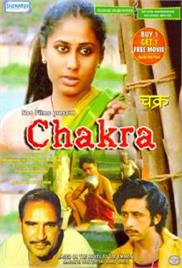Be Careful of Fake Websites. Always use HindiMovies.to domain & Join our Telegram Channel for Latest Updates.

Likes: 5
Views: 4.08K
Amma lives in Bijapur with her husband and son, Benwa. When a man attempts to sexually molest her, he is killed by her husband, the trio flee, but the husband is shot dead by the police. Amma re-locates to a shanty slum near Dharavi, Bombay, where Benwa grows up and shines shoes for a living. Amma is sexually active with Looka, a hoodlum and extortionist who shows up once in while, and also has a steady relationship with trucker, Anna. Both Looka and Anna are unaware of each other. Looka gets Benwa married to Amli from a nearby slum & Anna gets Amma a much better shelter. All seems to be going well until the Police come looking for an injured Looka, when he robs a pharmacy in order to get medicines for himself. Watch what happens when the Police arrive and find a visibly pregnant Amma with Looka, and the impact this will have on her relationship with Anna.
Duration: 140 min
Released: 1981
IMDb Rating: 7.2/10 (77 Votes)
Genre: Drama, Hindi Movies
Stars: Arun Bakshi, Ranjit Chowdhry, Suresh Bhagwat, Savita Bajaj
Directors: Rabindra Dharmaraj
Writers: Jaywant Dalvi, Rabindra Dharmaraj
Year: 1981
Server 1 – Openload
Server 2 – Vidto
Chakra (1981) – A Heartfelt Drama Reflecting Urban Struggles
Overview
Chakra is a 1981 Hindi drama film that profoundly captures the harsh realities of urban life in Mumbai. Directed by Rabindra Dharmaraj and featuring powerful performances from an ensemble cast including Smita Patil, Naseeruddin Shah, and Om Puri, the film is a stark portrayal of poverty, survival, and human resilience within the sprawling slums of the city.
Not merely a cinematic experience, Chakra stands out as an engaging social commentary that delicately weaves a narrative about the complex lives of marginalized people. The film was written with great sensitivity, reflecting the scriptwriter's deep understanding of slum life and the intricate human connections that sustain it.
Plot Summary
The story revolves around an elderly couple who, after years of living together in the bustling city of Mumbai, find themselves homeless and forced to live in a slum area known for its crime and poverty. They attempt to navigate this challenging environment, facing the everyday struggles and dangers inherent to slum life.
The narrative paints a vivid picture of survival, community, love, and betrayal through the lens of people who are often overlooked. The couple’s journey highlights societal neglect, but also reveals moments of kindness, solidarity, and human dignity amidst hardship.
In addition to the central characters, the film introduces a diverse cast portraying the residents of the slum, including petty criminals, hardworking laborers, and struggling families. Their intersecting lives form the 'chakra' or 'cycle' representing the endless loop of poverty and survival.
Main Cast and Crew
Direction and Writing
Rabindra Dharmaraj’s direction in Chakra is commendable for its naturalistic style. It avoids melodrama, choosing instead to focus on realistic portrayals of daily life. The camera work and setting transport the viewer directly into the confined spaces of Mumbai’s slums, emphasizing the claustrophobic environment that the characters inhabit.
The writing successfully captures the dialect and emotions of the characters, while carefully constructing a narrative that exposes the never-ending cycle of poverty—hence the title 'Chakra', meaning 'wheel' or 'cycle'. This cyclical theme is central to the film, prompting audiences to reflect on social inequalities and the durability of human spirit.
Music and Songs
Unlike many Bollywood films of its era, Chakra adopts a restrained musical approach, focusing more on story and drama than on elaborate song and dance numbers. The film does not feature a traditional soundtrack with multiple songs, which enhances its realistic and understated tone. This absence of musical distraction allows the narrative to remain firmly anchored in its social message.
Critical Acclaim and Legacy
Chakra was acclaimed for its unflinching look at slum life and the performances of its lead actors, particularly Smita Patil’s poignant portrayal. The film won several awards and remains an important work in Indian parallel cinema, recognized for its contribution to socially relevant storytelling.
It continues to be studied and admired for its honest depiction of poverty and urban struggle, bringing attention to issues that resonate even decades after its release.
Conclusion
Overall, Chakra (1981) is a powerful drama that uses realistic storytelling and evocative performances to shine a light on the cyclic nature of poverty in India’s urban slums. With its compelling narrative, strong direction by Rabindra Dharmaraj, and outstanding acting from Smita Patil, Naseeruddin Shah, and Om Puri, the film offers an insightful, deeply humanized look into a segment of society often ignored.
For viewers interested in socially conscious cinema that combines stellar performances with meaningful storytelling, Chakra stands as an essential watch.